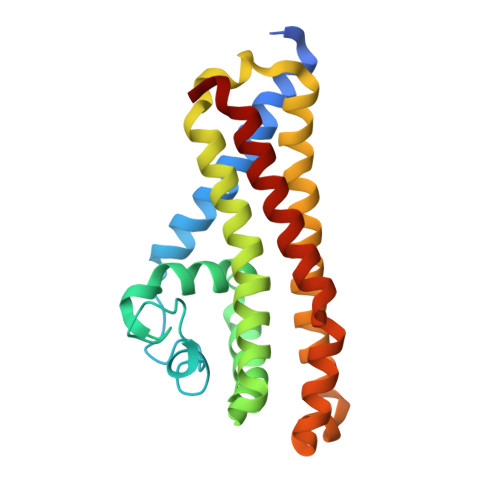Structural analysis of the outer surface proteins from Borrelia burgdorferi paralogous gene family 54 that are thought to be the key players in the pathogenesis of Lyme disease.
Brangulis, K., Akopjana, I., Petrovskis, I., Kazaks, A., Tars, K.(2020) J Struct Biol 210: 107490-107490
- PubMed: 32135236
- DOI: https://doi.org/10.1016/j.jsb.2020.107490
- Primary Citation of Related Structures:
6HPN - PubMed Abstract:
Lyme disease is a tick-borne infection caused by Borrelia burgdorferi sensu lato complex spirochetes. Through a complex enzootic cycle, the bacteria transfer between two different hosts: Ixodes ticks and mammalian organisms. At the start of the tick blood meal, the spirochetes located in the tick gut upregulate the expression of several genes, mainly coding for outer surface proteins. Outer surface proteins belonging to the paralogous gene family 54 (PFam54) have been shown to be the most upregulated among the other borrelial proteins and the results clearly point to the potential importance of these proteins in the pathogenesis of Lyme disease. The significance of PFam54 proteins is confirmed by the fact that of all ten PFam54 proteins, BBA64 and BBA66 are necessary for the transfer of B. burgdorferi from infected Ixodes ticks to mammalian hosts. To enhance the understanding of the pathogenesis of Lyme disease and to promote the development of novel therapies against Lyme disease, we solved the crystal structure of the PFam54 member BBA65. Additionally, we report the structure of the B. burgdorferi BBA64 orthologous protein from B. spielmanii. Together with the previously determined crystal structures of five PFam54 members and several related proteins, we performed a comprehensive structural analysis for this important group of proteins. In addition to revealing the molecular aspects of the proteins, the structural data analysis suggests that the gene families PFam54 and PFam60, which have long been referred to as separate paralogous families, should be merged into one and designated as PFam54_60.
- Latvian Biomedical Research and Study Centre, Ratsupites 1 k-1, LV-1067 Riga, Latvia. Electronic address: kalvis@biomed.lu.lv.
Organizational Affiliation:
















